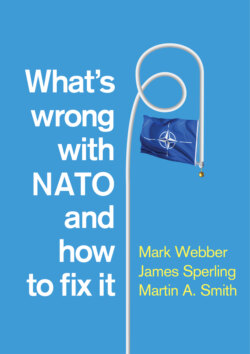Читать книгу What's Wrong with NATO and How to Fix it - Mark Webber - Страница 15
No organization is perfect
ОглавлениеPolitical organizations are rarely without fault, and few, if any, are perfect – able to act in complete accordance with the organization’s environment, to exercise flawless leadership and to mobilize resources efficiently and effectively to achieve its goals. While virtually all serious analysis would accept this as a starting point, opinion then differs on exactly how far organizations are constrained in action and effect.
An influential strand of realist opinion regards international organizations as mattering ‘only on the margins’. Such bodies operate primarily because states (and great powers in particular) harness organizations for their own ends. This may mean a temporary meeting of minds, but the cooperation that results is always fragile, temporary and likely to relapse toward more competitive ways of doing things.28 A somewhat different take (but an equally pessimistic one) argues that organizations develop entrenched ways of doing things and so become inherently inefficient. Rigid thinking and inflexible behaviour are especially evident in an organization’s bureaucracy, but such patterns can also influence state members who become socialized into bad habits. The outcome is a dysfunctional organization, unresponsive to its environment, preoccupied with process and wedded to policies that end up being ineffective and self-defeating.29
If we accept such views, then NATO would have to be judged against a very low bar, it being just one more flawed and ineffectual international body. Such a starting point would colour both our diagnosis of the problems besetting the Alliance and prescriptions for how to attend to them. We would, in short, steer to a rather limited range of options aware that NATO’s influence in the world was constrained and its future uncertain. Such a view is not without its merits. Indeed, even NATO’s defenders hold to some of its assumptions, not least the view that the Alliance is an arena in which the interests of its members are presented and sometimes collide, and that, ultimately, the US runs the show.
The following chapters demonstrate, however, that such a view is overstated and, in certain regards, inaccurate. The premise we follow in this book is aligned more with the institutionalist view that organizations can have significant effects.30 This does not mean that organizations are detached from their members – far from it. NATO, we suggest, has endured precisely because it serves its members’ interests. It offers ‘value-added’ to the allies in the shape of permanent, tried and trusted military and political cooperation. It goes beyond an alliance of convenience, coordinating defence and security in ways the allies could achieve neither alone nor in temporary coalition.
NATO’s distinct qualities do not, however, make it immune from the external challenges that have bedevilled other bodies. There is a view that the international system has entered a particularly unsettled time, one for which the current crop of international organizations (which largely originated after World War II) are ill suited. All organizations have to deal with uncertainty, but the chain of events beginning with the financial crash of 2008, and continuing with the Eurozone crisis, Russia’s annexation of Crimea, the 2015 migration crisis, Brexit, the election of Trump, the rise of populist politics in Europe and the COVID-19 pandemic, has been seen as ushering in a new dark age of problems.31 Such problems are, of course, real but perhaps no more troubling than those of previous decades. Robert Keohane argued in 1975 that ‘the world is in a profound political and economic crisis’ which has imposed severe ‘constraints on effective cooperative action’.32 The end of the Cold War gave rise to similar soul-searching as international organizations were immediately found wanting in the face of multiple crises, not least the wars in the former Yugoslavia.33 In 2007, Edward Newman wrote that a ‘crisis of multilateralism’ had typified much commentary on international organisations throughout the decade of the 2000s.34
The lesson one might draw here is twofold: that crises tend to typify international politics over time and that international organizations are central to how these crises play out. This is not to say that international organizations are always equal to the task, but as NATO’s case demonstrates, an organization can persist and adapt in the face of cumulative crises. What interests us, and what this book seeks to explore, is whether NATO’s adaptation to date is sufficient and how much further it should go.
